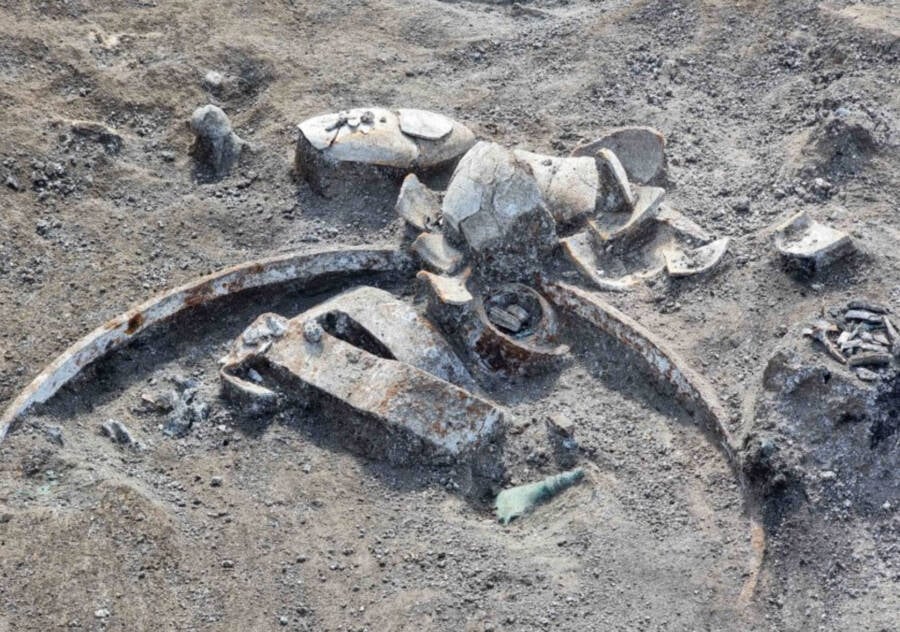While preparing for construction of a gas pipeline in eastern Bulgaria, archaeologists unearthed an ancient Roman necropolis complete with cremation pits, several mysterious stone structures, and a chariot.

BTAThe chariot is a two-wheeled model of the biga variety in which a lone rider stood up straight in a small car to operate the vessel.
In a first-of-its-kind find in Bulgaria’s Varna Province, archaeologists have discovered the remains of a Roman chariot, unearthed remarkably well preserved in a necropolis located between Vetrino and Provadia.
The excavation was headed by researchers from the Regional History Museum, who dated this necropolis mound to the second and third centuries C.E., placing it firmly in the Roman period — a surprise to many archaeologists who initially believed it would be much older.
The Discovery Of The Ancient Roman Necropolis In Bulgaria
Previously, researchers had looked into Early Bronze Age mounds near the newly excavated site, leading them to theorize that this one would come from the same period. To their shock, however, it actually proved to be far more recent, offering a wealth of Roman-era treasures, including the region’s first chariot.
As research team leader Dr. Vladimir Slavchev, an archaeologist from the Regional History Museum, told the Bulgarian News Agency (BTA), this mound was once the site of cremations during the Roman period, and it was seemingly constructed in multiple phases. Initially, grave pits would have been dug, in which the deceased were placed along with wooden funerary beds. After the body was burned, the pit was then filled in.

BTAThe mysterious stone structures found in Varna.
Over time, the mound was gradually covered with rock and soil, then eventually expanded to include mysterious stone structures that remain intact today. As Slavchev explained, these stone structures were closely packed together and elliptical in shape, but their exact purpose remains a mystery. In fact, the structures are seemingly empty and feature no signs of any human destruction, leading researchers to the conclusion that they had not been looted.
As for the bodies, because they were burned, it is effectively impossible for researchers to determine whether the dead came from the same family. Given the presence of an ancient settlement nearby, though, Slavchev believes that this necropolis was likely used by a larger circle of the local population.
Within the mound itself, researchers discovered the cremation pits and a few grave goods that offer some clues as to the social status of the deceased. No gold items were found in the pit, but there were fragments of ceramic and glass vessels, as well as various iron and bronze artifacts. There were also several Roman coins, which would have served as an offering for the deceased to pay for passage in the afterlife.
Of course, the most fascinating discovery at the site was a Roman chariot buried alongside the remains of a horse.
The First Roman Chariot Ever Found In The Region
The chariot was known as a “biga,” the two-wheeled type often depicted in movies. It was, according to Slavchev, incredibly well preserved and can likely be reconstructed.

BTAThe chariot would have been operated by a lone rider in a standing position.
Often, Slavchev noted, these sorts of chariots were used for transportation, but he believes this particular one may have been used in war. While it is not the first time that such a chariot has ever been found in Bulgaria, it is the first time that one was found in the Varna region, making it something of a rarity.
Meanwhile, other chariots from the days of ancient Rome have been found elsewhere in Europe, including one found in Pompeii as well as an entire circus for chariot racing uncovered in Spain.
It is remarkable that the newly-found chariot was even still there, as it turns out, because while the stone structures may not have been looted, there were four raids by treasure hunters on the burial mound itself. As such, if there had been any object within it that could be used to identify the dead who were buried there, it is now long gone.
In any case, it is fortunate that the archaeologists made this discovery when they did, as the mound lies directly on the route of a future gas pipeline that will run through the region.
After reading about this Roman era necropolis in Bulgaria, see our gallery of stunning photographs of abandoned Bulgarian towns. Then, read about venationes, ancient Rome’s staged animal hunts.





